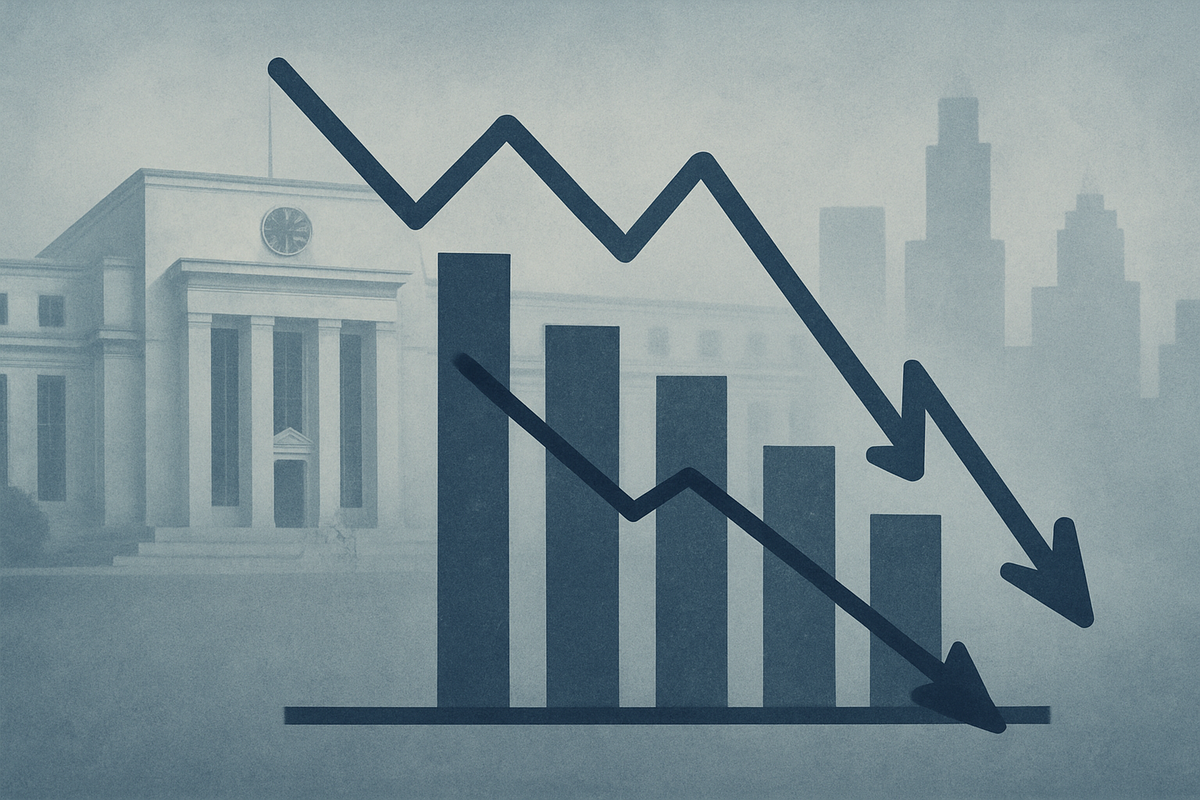
The U.S. labor market has shown unexpected signs of fragility in early August 2025, with a surprisingly weak job growth report for July and significant downward revisions to previous months' data. This sudden deceleration in job creation has sent ripples through financial markets and intensified speculation about the Federal Reserve's next moves, particularly regarding the timing and magnitude of interest rate cuts. The shift suggests a broader loss of economic momentum, potentially signaling a more challenging environment for businesses and consumers alike.
A Cooling Engine: What Happened and Why It Matters
The latest data revealed a stark picture of a cooling labor market. Total nonfarm payroll employment increased by a mere 73,000 jobs in July 2025, significantly missing economists' forecasts which had anticipated gains between 110,000 and 115,000. Even more concerning were the substantial downward revisions to prior months' figures: May's initial estimate of 144,000 jobs was slashed to just 19,000, and June's 147,000 was cut to a meager 14,000. This means the average monthly job growth over the past three months has plummeted to approximately 35,000, a dramatic decline from the 168,000 monthly average seen in 2024. The unemployment rate also edged up slightly to 4.2% in July, from 4.1% in June, though it has remained within a narrow range since May 2024. Job creation in July was heavily concentrated, with healthcare adding 55,000 jobs and social assistance contributing 18,000, together accounting for 94% of the total growth, while federal government employment continued its decline.
This unexpected weakening of the labor market holds significant implications for the Federal Reserve. Previously, the Fed had been navigating a tightrope between controlling inflation and maintaining employment. However, the latest jobs report, coupled with other indicators like slower consumer spending, suggests that the economy's momentum is waning faster than anticipated. Federal Reserve Chair Jerome Powell has acknowledged these increasing downside risks to employment, hinting at potential adjustments to interest rates.
This has fueled expectations for rate cuts, with institutions like J.P. Morgan Global Research now forecasting a September rate cut followed by three more 25-basis-point cuts, and Goldman Sachs also projecting multiple cuts before year-end. U.S. Treasury Secretary Scott Bessent even advocated for a half-point cut in September, suggesting earlier action might have been taken if this data were available sooner. The Fed's challenge is compounded by ongoing inflationary pressures from tariffs, creating a complex dilemma for policymakers.
Navigating the Shift: Potential Winners and Losers
A weakening labor market and the prospect of Federal Reserve interest rate cuts typically create a mixed bag of winners and losers across the corporate landscape. Companies that are highly sensitive to borrowing costs, such as those in the real estate and construction sectors, could see a significant boost. Lower interest rates make mortgages and development loans more affordable, potentially stimulating demand for housing and commercial projects. Homebuilders like D.R. Horton (NYSE: DHI) and Lennar Corporation (NYSE: LEN), along with real estate investment trusts (REITs) focused on residential or commercial properties, might experience increased activity and improved profitability. Similarly, businesses with substantial debt loads could benefit from reduced interest expenses, freeing up capital for investment or shareholder returns.
Conversely, sectors that thrive on robust consumer spending and a strong employment picture might face headwinds. Retailers, particularly those selling discretionary goods, could see a slowdown in sales as consumers become more cautious amid job market uncertainty. Companies like Amazon (NASDAQ: AMZN) and Walmart (NYSE: WMT), while diversified, could feel the pinch of reduced consumer confidence. Financial institutions, especially banks, might also face challenges. While lower rates can stimulate lending, they can also compress net interest margins, the difference between what banks earn on loans and pay on deposits. Large banks such as JPMorgan Chase (NYSE: JPM) and Bank of America (NYSE: BAC) could see their profitability impacted if the rate cuts are aggressive and sustained. Technology companies, while often seen as growth-oriented, could also face scrutiny if economic growth slows, potentially impacting their revenue projections and investor sentiment.
Broader Economic Ripples: Industry Impact and Implications
The recent U.S. labor market data fits into a broader narrative of an economy grappling with the after-effects of rapid inflation and aggressive monetary tightening. For months, the Federal Reserve has been trying to engineer a "soft landing," cooling the economy enough to bring down inflation without triggering a recession. The latest jobs report suggests that the landing might be bumpier than anticipated, or perhaps even heading towards a harder one. This slowdown in job growth, coupled with other indicators like moderating consumer spending, points to a broader loss of economic momentum that could ripple through various industries. Manufacturing, which has already shown signs of contraction in some areas, could face further demand-side pressures. The service sector, which has been a strong driver of job growth, particularly in healthcare and social assistance as highlighted in the report, might see its resilience tested if overall economic activity continues to decelerate.
The potential for aggressive rate cuts by the Federal Reserve has significant policy implications. It signals a pivot from an inflation-fighting stance to one more focused on supporting employment and economic growth. This shift could lead to increased scrutiny of the Fed's dual mandate and its ability to balance these objectives. Furthermore, the U.S. administration's ongoing tariff policies, which contribute to inflationary pressures, create a complex policy environment. The Fed's actions to stimulate the economy through lower rates could be partially offset by the inflationary impact of tariffs, creating a push-pull dynamic that complicates economic forecasting and policy effectiveness. Historically, periods of rapid deceleration in job growth have often preceded economic downturns, raising concerns about a potential recession. Comparisons to previous cycles where the Fed had to reverse course quickly due to weakening economic data are likely to emerge, prompting a re-evaluation of current economic models and forecasts.
The Road Ahead: What Comes Next
In the short term, markets will be keenly watching for further economic data releases, particularly inflation figures and subsequent labor market reports, to gauge the Federal Reserve's next move. The September Federal Open Market Committee (FOMC) meeting is now a focal point, with a high probability of an interest rate cut. The magnitude of this cut – whether 25 or 50 basis points – will be crucial in shaping market expectations for the remainder of the year. Companies will need to strategically pivot, potentially re-evaluating their hiring plans, capital expenditure projects, and debt management strategies in anticipation of a lower interest rate environment and potentially slower economic growth. Businesses with strong balance sheets and efficient operations will be better positioned to navigate this period of uncertainty.
Looking further ahead, the long-term possibilities include a sustained period of lower interest rates, which could stimulate investment and borrowing, but also potentially lead to asset bubbles if not managed carefully. Alternatively, if the labor market continues to weaken significantly, the U.S. economy could face a more pronounced slowdown or even a recession, despite the Fed's efforts. This would present significant challenges for corporate earnings and employment. Market opportunities may emerge in sectors that are traditionally defensive or benefit from lower rates, such as utilities, consumer staples, and certain technology segments that offer essential services. Investors should closely monitor the Fed's communications, inflation trends, and corporate earnings reports for signs of economic resilience or further deterioration. The interplay between monetary policy, fiscal policy (tariffs), and global economic conditions will define the landscape for the coming months and years.
Conclusion: A Critical Juncture for the U.S. Economy
The surprisingly weak U.S. labor market report for July 2025, marked by significantly lower job growth and substantial downward revisions, represents a critical turning point for the economy and monetary policy. It signals a clear deceleration in economic momentum, pushing the Federal Reserve closer to implementing interest rate cuts sooner and potentially more aggressively than previously anticipated. While lower rates could offer a lifeline to certain sectors and indebted companies, they also underscore concerns about broader economic weakness and the potential for a more challenging environment for consumer spending and corporate profitability.
Moving forward, the market will be highly sensitive to the Fed's actions and subsequent economic data. Investors should prepare for increased volatility and consider adjusting their portfolios to account for a potentially softer economic landing or even a mild recession. Key takeaways include the Fed's likely pivot towards easing, the mixed impact on various industries, and the complex interplay of monetary and fiscal policies. What investors should watch for in the coming months are the specifics of the Fed's rate decisions, inflation trends, and how corporate earnings reports reflect the changing economic landscape. The resilience of the U.S. economy will be tested, and strategic adaptation will be paramount for businesses and investors alike.






